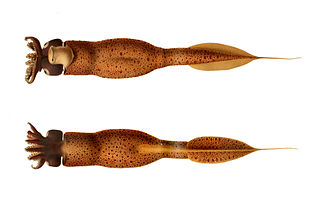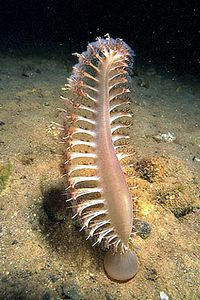
The Lampyridae are a family of insects in the beetle order Coleoptera with more than 2,000 described species. They are soft-bodied beetles that are commonly called fireflies, glowworms, or lightning bugs for their conspicuous use of bioluminescence during twilight to attract mates or prey. Fireflies produce a "cold light", with no infrared or ultraviolet frequencies. This chemically produced light from the lower abdomen may be yellow, green, or pale red, with wavelengths from 510 to 670 nanometers. Some species such as the dimly glowing "blue ghost" of the Eastern U.S. may seem to emit blueish-white light from a distance and in low light conditions, but their glow is bright green when observed up close. Their perceived blue tint may be due to the Purkinje effect.

The Squaliformes are an order of sharks that includes about 126 species in seven families.

Bathyteuthis is the singular genus of squid in the family Bathyteuthidae, encompassing three species. None has a mantle length greater than 80 mm.

Histioteuthis is a genus of squid and the only member of the Histioteuthidae family. It goes by the common name cock-eyed squid, because in all species the right eye is normal-sized, round, blue and sunken; whereas the left eye is at least twice the diameter of the right eye, tubular, yellow-green, faces upward, and bulges out of the head.
Glowworm or glow-worm is the common name for various groups of insect larvae and adult larviform females that glow through bioluminescence. They include the European common glow-worm and other members of the Lampyridae, but bioluminescence also occurs in the families Elateridae, Phengodidae, and Rhagophthalmidae among beetles; as well as members of the genera Arachnocampa, Keroplatus, and Orfelia among keroplatid fungus gnats.

Tomopteris is a genus of marine planktonic polychaetes. All described species are known to be holoplanktic, meaning that they spend their entire life cycles in the water column.

Galiteuthis is a genus of glass squids from the family Cranchiidae and the subfamily Taoniinae. Squids in the genus Galiteuthis are large squids with mantle lengths measuring up to 660mm, although it has been suggested that mantle length could reach as much as 2.7m. The most distinctive feature of the speciesa in this genus are they have hooks on the tentacular clubs while there are no hooks on the arms, and by their long, thin, terminal fins.

Taonius is a small genus of glass squid. Although it comprises only three recognised species, it has been suggested there may be as many as five species. Taonius borealis is found in the North Pacific Ocean and Taonius pavo is found in the Atlantic and possibly SW Indian Ocean.

Teuthowenia is a genus of glass squid in the subfamily Taoniinae. Members of this genus are characterized by their deep-sea habitat, clear bodies, and ability to engorge themselves with water to become larger when threatened. Each known species has a visible digestive gland, which serves a similar purpose as a stomach and liver.
Mastigoteuthis is a genus of whip-lash squid containing at least seven valid species. Some teuthologists consider Idioteuthis synonymous with this taxon.
Echinoteuthis is a genus of whip-lash squid containing approximately three to five species. Some teuthologists consider Idioteuthis synonymous with this taxon.

The Abylidae are a family of marine invertebrates in the order Siphonophora. They are colonial, but the colonies can superficially resemble jellyfish; although they appear to be a single organism, each specimen is actually a colony of Siphonophora.

Physonectae is a suborder of Siphonophores. In Japanese it is called 胞泳.
Rosacea is a genus in the Prayidae. The genus contains bioluminescent species.

Pennatula is a genus of sea pens in the family Pennatulidae. The genus contains several bioluminescent species, including Pennatula rubra, Pennatula phosphorea, and Pennatula aculeata.
Stachyptilum is a genus in the family Stachyptilidae. The genus contains bioluminescent species.

Umbellula is a genus of cnidarians in the monotypic family Umbellulidae. The genus contains bioluminescent species.

Veretillum is a genus in the family Veretillidae. The genus contains bioluminescent species.

Syllis is a genus of marine bioluminescent polychaete worms.
Bassia is a monotypic siphonophore genus in the family Abylidae. The genus only contains the bioluminescent species Bassia bassensis.














